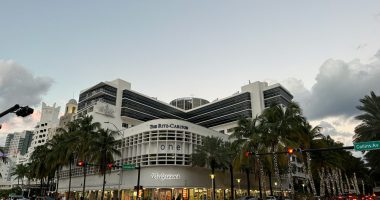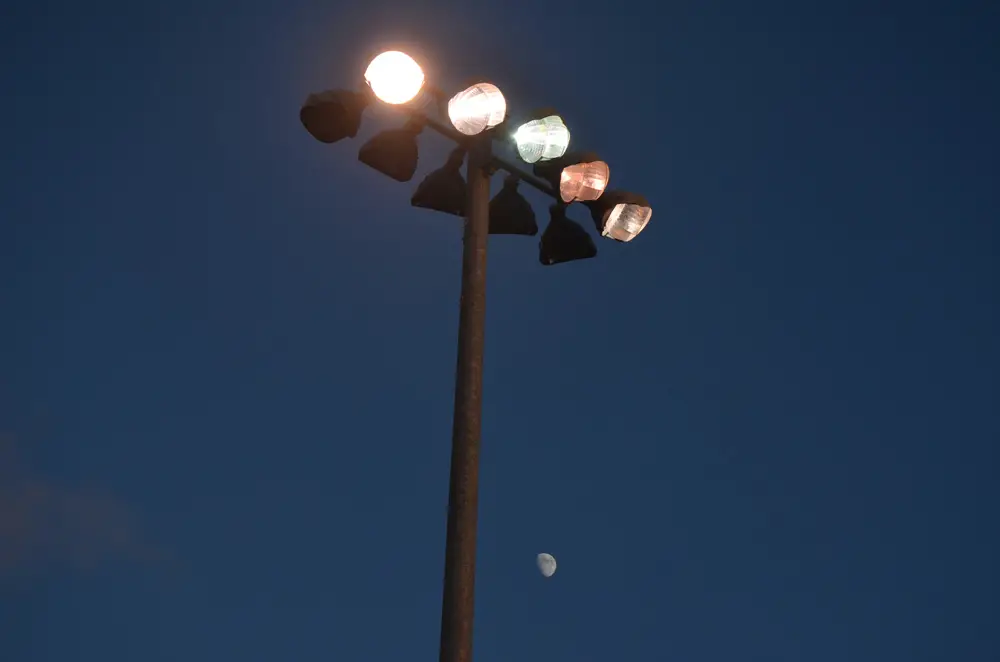
When the Palm Coast City Council gets its administration’s latest report on the state of Ralph Carter Park in the R-Section, it’ll have to decide how much of the sound and fury again hemming the popular park is the grousing of a few people signifying nothing or a reflection of a broader problem.
Judging from a community meeting the administration hosted at City Hall Wednesday evening, there is no broad problem. The meeting was designed to hear residents’ concerns and feedback, and to provide information about what changes or improvements R-Section residents may expect at their neighborhood park over the next few months.
The chamber was a phalanx of empty chairs. Eight city residents turned up, not all of them from the R-Section. There were six sheriff’s deputies when the meeting started, two staffers–Chief of Staff Jason DeLorenzo and Parks and Recreation Director James Hirst–and two reporters.
The complaints of a few–actually, a husband and wife whose complaints have a history dating back to 2010, and a third person–seemed to make up in shrillness, decibels and occasional rudeness towards DeLorenzo and cooler heads in the audience what lacked in people. If anything, Ralph Carter, named for one of the council’s early members, is a victim of its success as one of the city’s handsome parks in a limited but luxurious and well managed inventory of parks (though the fields need work).
The evening meeting lasted 90 minutes, about 60 minutes of which were dominated by Marion Petruzzi, a resident of Richardson Drive, to the northeast of the park, but not directly at the rim of the park. Petruzzi 14 years ago had led the campaign against what she then called “undesirables” who were cutting through yards to get to the park, and for a fence along Richardson Drive that the city at first resisted, then granted. The fence is still there. (“Undesirables” is the usual code for young Blacks in a whiter neighborhood that’s occasionally had racist flareups.)
When she would appear before the City Council in 2010 she claimed to “represent everybody in our group and we are actually afraid to come out of our vehicles in the evening,” though, oddly, she almost alone would appear before the council. Wednesday evening Petruzzi claimed to represent “hundreds of families,” though, oddly, she was almost alone at the community meeting. She said the others are afraid to come out, and also afraid to call the cops or the city, leaving her bearing their cross.
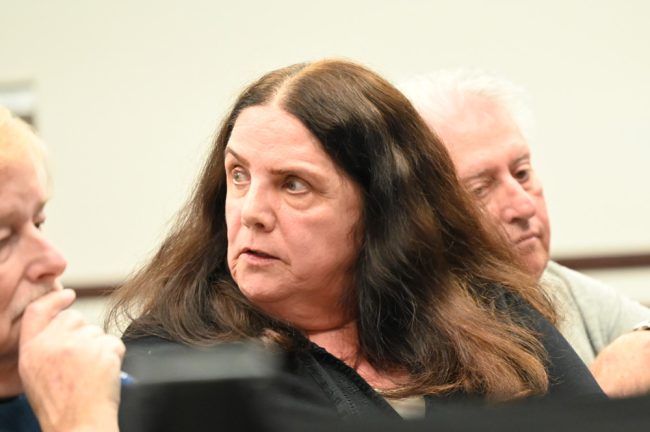
It isn’t clear what they’re afraid of, assuming they exist. When Ed Fuller, a representative of Crime Stopers, asked her if they ever called Crime Stoppers’ anonymous line, she cut him off, told him Crime Stoppers doesn’t work, and talked about what has been happening for 13 years. “I hear it all, and it’s all on my shoulders,” she said. Fuller tried again, explaining to her how she and others can call Crime Stoppers anonymously or leave a tip and have their information confidentially passed over to the Sheriff’s Office.
“People do not want to risk calling anyone. That’s why it’s on me for 13 years,” Petruzzi said.
There was no mention of “undesirables” Wednesday evening. Rather, it came down to this, from Petruzzi’s and her husband’s perspective: the lights at Ralph Carter Park are on too late, they stay on even after people have left, and there are way too many people at the park, yelling and screaming and preventing the “hundreds of families” Petruzzi allegedly represents from enjoying the peace and quiet everyone else in Palm Coast enjoys. (The Petruzzis’ property value has not been harmed by the proximity to the park, or to Rymfire Elementary: it has increased by 150 percent since 2010, according to the Flagler County Property Appraiser.)
Petruzzi said repeatedly that “several hundred” people are on the fields, though no organized sports offered there (softball, flag football, soccer) involve more than a couple of dozen participants per field at any given time. Bottom line: she and her husband want the city to remove the lights and the competitions to other parks in the city. “There’s plenty other places,” she said, citing Matanzas High School and the Indian Trails Sports Complex, among others.
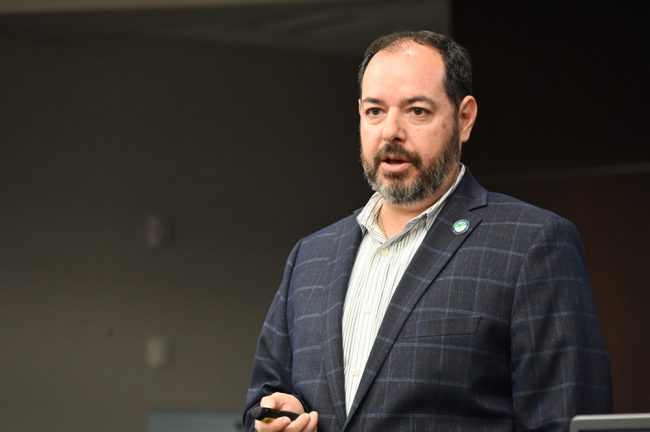
In fact, the city has just five locations with playing fields, and only two with lighted fields: Ralph Carter Park and Indian Trails Sports Complex. Holland Park, Belle Terre Park and Seminole Woods Park, all neighborhood parks, have two or three fields each, but they’re not lit. (See the inventory here.) The Petruzzis had a point: why did the city choose just Ralph Carter Park to light up?
The lights have been in place since the park was built over 14 years ago. Back then, Petruzzi complained that the lights should not be on past 9 p.m. These days they’d been staying on until 10 p.m., if users had permits to play under the lights, but the city is moving that back to 9 p.m. In 2022-23, almost 500 permits were issued to users of Ralph Carter Park fields. The basketball and volleyball courts will still be lit as late as 10 p.m. when in use (those courts’ lights are on timers users operate.)
There’s no question that the fields are very popular, and that Palm Coast has a field deficit, for which people like the Petruzzis are paying a price. There’s no question, either, that the fields provide an outlet for thousands of children–2,000 participate in any one of the available leagues such as Mad Dogs Flag Football (400 participants), Palm Coast Little League (458) or the four available soccer leagues (1,138 participants between them), though some of those are cross-overs.
“When kids and teens are in a park, that’s a lot better place for them to be than out in the street,” DeLorenzo said.
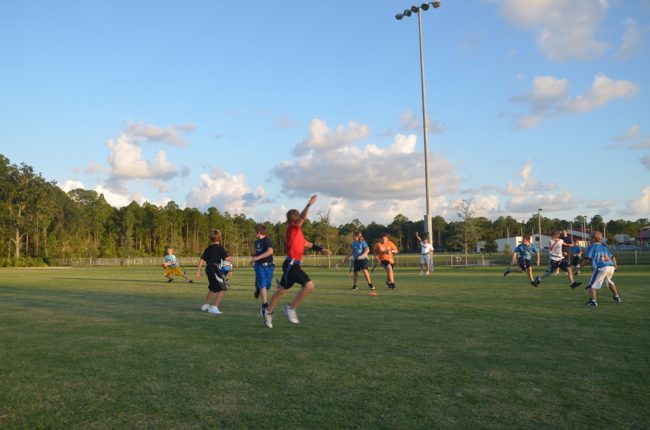
The Petruzzis said they support children’s sports–just not at Ralph Carter Park. “It’s a residential park, there’s houses right up against the property line and we’ve got to put up with that crap,” the resident sitting alongside the Petruzzis said. “It never should have been put in the middle of a residential neighborhood to begin with.”
Lights have been a recurring issue. Ten light poles frame the park’s two lit fields. DeLorenzo said the city’s lighting consultant, Musco, will be doubling the length of the shields on the lights, from 7 to 14 inches, and redirecting lights where necessary, to reduce light pollution. That’ll happen in mid-March. Installing LED lights was considered, but it’s too expensive and would require the installation of additional poles. The park will also be resodded in summer and fall.
“We’re trying to balance the community’s needs with fields and the neighborhood’s needs or the neighborhood’s character,” said DeLorenzo, who managed never to lose his composure in the face of Petruzzi’s repeated aggressions and mischaracterizations (“you’re a good person but you’re insulting our intelligence,” she told him at one point).
Another resident spoke more admirably of the city’s parks and its general efforts to be responsive to residents. “We’re we’re very impressed with what the city does,” he said, saying he and his family had just moved to Palm Coast five months ago. “We spent a year in Daytona and I can tell you, we couldn’t get out of there quicker, across the street from the racetrack in an apartment that was extremely expensive.” His wife complained of homeless individuals sleeping on the apartment building’s entrance.
He urged critics to give the city time to enact its planned improvement–then felt compelled to implore Petruzzi not to attack him for his suggestions. She lectured him instead. “These lights are on their house like a spaceship hovering our whole neighborhood. People call me crying,” she said.
Both de Lorenzo–who had been to Petruzzi’s house to listen to her complaints 13 years ago, when he was a city council member–and Hirst said they have not received the type of complaints from the number of residents Petruzzi claims are out there.
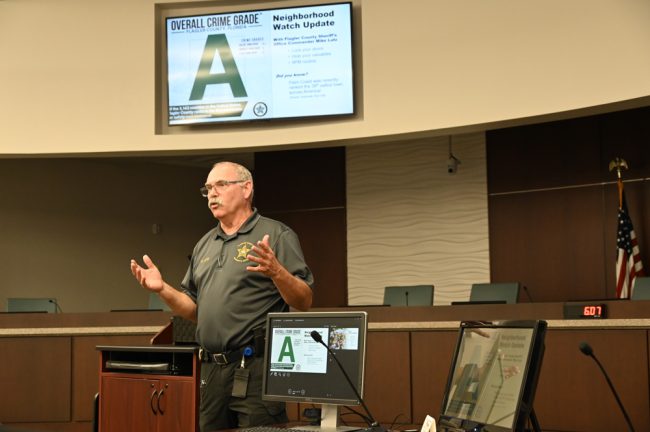
The meeting had begun with a presentation by the Sheriff’s Cmdr. Mike Lutz, a popular figure on the local circuit of neighborhood, home owners’ associations and civic groups’ meetings. He’s honed his presentation over hundreds of such meetings like a stand-up preparing a Netflix special. He summed up the state of crime, or more precisely the relative lack of crime, around the park and in Palm Coast, and talked about neighborhood watches, giving a few suggestions. “This is Palm Coast, not a lot of crime,” he said. “We are safe, crime is down, since 2016, crime is down over 50 percent.”
The local Neighborhood Watch system is not what it once was: low crime means less interest in these regimented approaches, so these days neighborhood watches are more on the scale of entire sections, and even then, the F Section’s Neighborhood Watch dwindled to the point of merging with the C-Section. The R Section has a section-wide watch, headed by… Marion Petruzzi.(“I’ve been in a neighborhood watch leader for 13 years,” she said, “and I worked real hard.”)
Lutz recommended the see-something-say-something approach when residents are out walking their dog, biking, ambling about. “If it’s suspicious to you, it’s suspicious to us,” he said. “We’d rather get 99 calls that turn out to be absolutely nothing and not get that one call where somebody’s house got broken in.” He reminded his audience that if they think someone looks suspicious, “if you don’t like them or you don’t like the way they look, it’s not really a crime.” Actually, it’s not a crime, period.
“What about the homeless, and where are the crime spots?” a resident asked.
“Well, it isn’t illegal to be homeless,” Lutz said, and there are no such things as “crime spots” in Palm Coast. There are occasional crime sprees, when teens or others decide to hit up a section’s cars for crimes of opportunity. But otherwise, crime, such as it is in Palm Coast, is one of the city’s more equal-opportunity phenomena, favoring no area in particular.
As the meeting wound down, Petruzzi offered a sarcastic summary of what she’d heard, essentially deriding the city. “Everything’s going to stay the same as before, there’s still going to be hundreds of kids on the field as we’ve been seeing every single night,” she said, comparing her life to that of a prisoner in her own home. “So then we will continue to complain about the hundreds of families and and players on the field every single night.”
An R-Section resident approached a reporter after the meeting and said: “You’re a journalist. The word here is hyperbole.”
![]()
Ralph Carter Park Community Meeting





